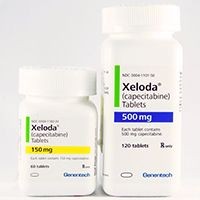
Contents
- 1 capecitabine (Xeloda)
- 1.0.1 Uses for capecitabine (Xeloda)
- 1.0.2 Side effects of capecitabine (Xeloda)
- 1.0.3 Dosage for capecitabine (Xeloda)
- 1.0.4 Drug interactions with capecitabine (Xeloda)
- 1.0.5 Is capecitabine (Xeloda) safe during pregnancy or breastfeeding?
- 1.0.6 Additional information about capecitabine (Xeloda)
- 1.0.7 Summary
- 1.0.8 Related Disease Conditions
- 1.1 Cancer
- 1.2 Colon Cancer (Colorectal Cancer)
- 1.3 Breast Cancer
- 1.4 Gastroesophageal Junction Adenocarcinoma
- 1.5 Anal Cancer
capecitabine (Xeloda)
Capecitabine is an oral medication for treating advanced breast cancer resistant to combination therapy with paclitaxel (Taxol) and doxorubicin (Adriamycin). It is converted to 5-fluorouracil (5-FU) by the body, a drug used intravenously to treat various types of cancer. Thus, capecitabine is effective in treating colorectal cancer, which is often treated with 5-FU. 5-FU inhibits cancerous cell production of DNA and protein necessary for cell division and cancer growth. The FDA approved capecitabine in 1998 for breast cancer treatment and in 2005 for colorectal cancer treatment.
Brand names for capecitabine
Is capecitabine available as a generic drug?
GENERIC AVAILABLE: No
Do I need a prescription for capecitabine?
Uses for capecitabine (Xeloda)
Capecitabine (Xeloda) is prescribed to treat:
- colon cancer that has spread to lymph nodes near the colon (Dukes’ C stage) after surgery.
- colon or rectal cancer that has metastasized.
- metastatic breast cancer in combination with docetaxel after other treatments have failed.
- breast cancer that has not improved after treatment with paclitaxel and other anti-cancer drugs, or if further treatment with certain anti-cancer drugs is not possible.
Side effects of capecitabine (Xeloda)
The most common side effects of capecitabine include:
- diarrhea
- nausea
- vomiting
- painful swelling of the mouth
- fatigue
- painful rash
- swelling of the hands or feet
- low white blood cell count
- low blood platelet counts
- anemia
Other important side effects include:
- heart attacks
- chest pain
- abnormal heart beats
Dosage for capecitabine (Xeloda)
The recommended dose is 1250 mg/m2 twice daily, approximately 12 hours apart. Take tablets 30 minutes after eating. Capecitabine is usually prescribed in 3-week cycles, with two weeks of treatment followed by one week without the drug. Some patients may require lower or delayed doses due to side effects.
Drug interactions with capecitabine (Xeloda)
Capecitabine can interact with blood thinners like warfarin (Coumadin), increasing the risk of life-threatening bleeding. This can occur shortly after starting capecitabine or even up to a month after stopping it. Patients with cancer and those over 60 years of age are at a higher risk. Inform your doctor if you are taking warfarin or another blood thinner before starting capecitabine. Regular blood tests may be necessary during and after treatment to monitor clotting speed and adjust blood thinner dosage if needed. Capecitabine may interact with other drugs, both over-the-counter and prescription, as well as herbal supplements. Inform your doctor of all medications you are taking.
Is capecitabine (Xeloda) safe during pregnancy or breastfeeding?
Capecitabine can harm the fetus and should not be taken by pregnant women. It is unknown whether capecitabine is secreted in breast milk.
Additional information about capecitabine (Xeloda)
Available preparations of capecitabine
Tablets: 150 and 500 mg.
How to store capecitabine
Store tablets at room temperature, between 15C to 30C (59F to 86F).
Summary
Capecitabine (Xeloda) is prescribed as a treatment for advanced breast cancer that is resistant to other commonly used drugs. Prior to taking this medication, review its side effects, drug interactions, and pregnancy safety information.
Related Disease Conditions
Cancer
Cancer is an abnormal growth of cells, also called malignancy. It is a group of 100 different diseases and is not contagious. Chemotherapy is used to treat cancer by destroying cancer cells.
Colon Cancer (Colorectal Cancer)
Colon cancer, or colorectal cancer, arises from the inner lining of the colon. Most of these cancers develop from colonic polyps. Removing these precancerous polyps can prevent colon cancer.
Breast Cancer
Breast cancer is an invasive tumor that develops in the mammary gland. Mammograms, breast self-examination (BSE), biopsy, and specialized testing are used to detect breast cancer. Treatment may involve surgery, radiation, hormone therapy, chemotherapy, and targeted therapy. Breast cancer risk can be lowered by managing controllable risk factors. Breast cancer is the most common cancer among American women, and one in every eight women in the United States develops breast cancer. There are many types of breast cancer that differ in their ability to metastasize. The causes of breast cancer are unknown, but several risk factors have been identified. Early signs and symptoms include a lump in the breast or armpit, nipple discharge, inverted nipple, skin texture changes, breast pain, nipple soreness, swollen lymph nodes, and changes in breast or nipple size or shape. Early detection is important and can be achieved through regular screenings. Diagnosis is made through physical exams, self-examination, mammography, ultrasound, and biopsy.
Gastroesophageal Junction Adenocarcinoma
Gastroesophageal junction adenocarcinoma is cancer that forms where the esophagus joins the stomach. The risk of developing this cancer is higher in individuals with GERD and Barrett’s esophagus. Symptoms include difficulty swallowing, weight loss, dark stool, coughing, nausea, and vomiting. Treatment options include surgery, chemotherapy, radiation therapy, immunotherapy, and targeted therapy.
Anal Cancer
Anal cancer occurs at the end of the large intestine and may cause symptoms such as rectal bleeding, anal pain or pressure, anal discharge or itching, changes in bowel movements, or a lump in the anal region. Treatment options include radiation, chemotherapy, and surgery, and the prognosis is typically good if the cancer is caught early.


